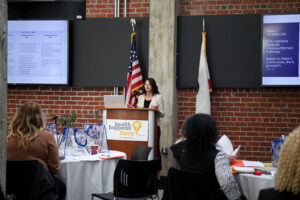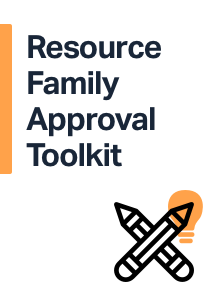Relatives are critical to the success of CCR, as relatives currently provide placement for over 38% of the state’s more than 62,000 foster children and are the most likely to provide a home to older youth stepping down from a group home. Studies suggest that children placed with relatives experience less trauma, stronger bonds with siblings and extended family members, and are less likely to experience multiple placements, among other positive outcomes. Given the importance of kinship caregivers to our foster care system, it is important to understand how the new Continuum of Care Reforms impact kin and how to make the new system work for our kinship caregivers.
California’s Continuum of Care Reform (CCR) is making big changes to the way a family is approved to be a foster home. By 2017, the only way to be approved as a new foster parent will be to go through Resource Family Approval (RFA); families already approved prior to January 2017 will have additional time to convert to the new RFA standards. Relatives will be substantially impacted by implementation of RFA because they will have to go through new risk assessment and psychosocial assessment processes, and meet new training requirements.
While relatives are, and should be, held to the same high standards as non-relative foster parents, it is important that counties that are working to implement the new RFA standards take account of the very different way that relatives enter the foster care system. Non-relatives enter the system by deciding to become a foster family, followed by months of training, preparation, home approval, and then matching with a child or children. Relatives, in contrast, enter the system in a crisis situation such as a late-night phone call informing them that their grandchild, niece or nephew has been detained by the child welfare agency.
Current law allows children to be placed with relatives (and non-relative extended family members such as neighbors, godparents, etc.) on an emergency basis prior to home approval. This policy protects children from needless trauma by providing a familiar caregiver at a time of crisis and disruption – but it presents unique challenges for relatives, who must complete home approval requirements while they are already caring for traumatized and grieving children. Relatives have not had the luxury of setting aside money and vacation days, modifying their homes to meet licensing standards, finding child care, etc. in advance of placement.
It is critical that as we implement RFA statewide, the policies and local practices take account of the unique circumstances of kinship families and respond to their needs. Examples of best practices for approving kinship caregivers under the new Resource Family Approval process include:
- Ensure that kinship caregivers who are caring for children on an emergency basis have funding in place while they work to be approved. At a minimum, these families should be given the expedited CalWORKs application so that they can access CalWORKs funding pending approval. [link to expedited CalWORKs application]
- Offer child care at trainings or bring the trainings to the families during the in-home visits;
- Take time to explain the approval process and to work with the kinship family to complete any paperwork;
- Assist the kinship caregivers in gathering necessary documents and information;
- Require 12 hours of pre-approval training to ensure that families who take in children on an emergency basis are not penalized by having to complete more than 12 hours of training before funding can start. Counties can require any number of post-approval training hours and, in addition, require those post-approval hours be completed prior to any non-emergency placements;
- Create community partnerships with advocates, judicial officers, other county agencies (like probation and mental health), and providers to ensure that the needs of relatives are being accounted for across the entirety of the system;
- Have specific protocols and practices for emergency placements in order to ensure that families are supported through the approval process;
Once a kinship family is approved as a Resource Family, the child will be eligible for the new Resource Family Basic Rate at the child’s assessed level of need. This is the first time in California’s history that relatives caring for a foster child will receive access to the same support and funding rates as all other foster families. While the funding stream that is utilized may differ (i.e. some kinship caregivers will receive a Resource Family Rate paid with AFDC-FC dollars while others will receive the same rate level through ARC dollars), the amount of funding available to the child and the family will be equal to that of all other foster families. In order to ensure that there is no confusion for kinship caregivers in accessing the new rates, counties should consider the following:
- Ensure that any paperwork that is different from that of a non-relative foster parent is explained and that the relative has assistance in completing any necessary forms;
- Whenever possible, use the same processes and protocols for establishing the funding for kinship caregivers;
- Track placements and funding in order to create a monthly report that ensure that families are timely accessing benefits and to track the child’s level of care;
Partnering with kinship caregivers and recognizing the unique and valuable role these families play within our system is key to the success of CCR. Together, we can ensure that every child is raised in a family.








